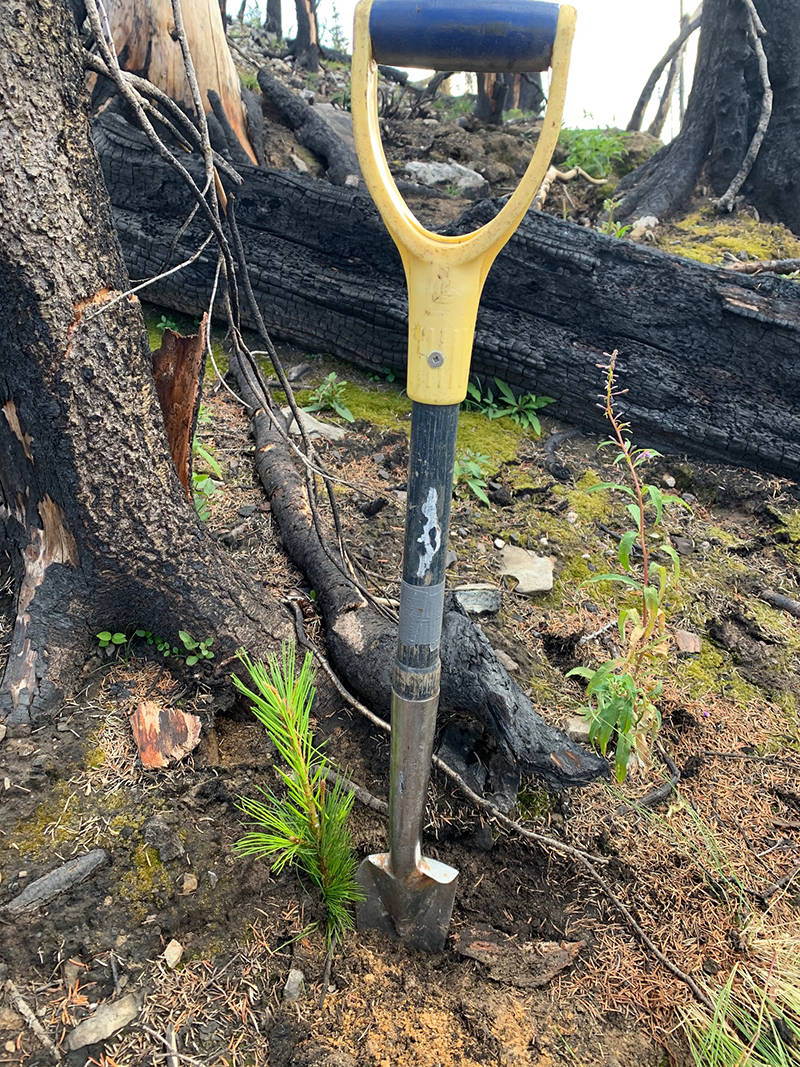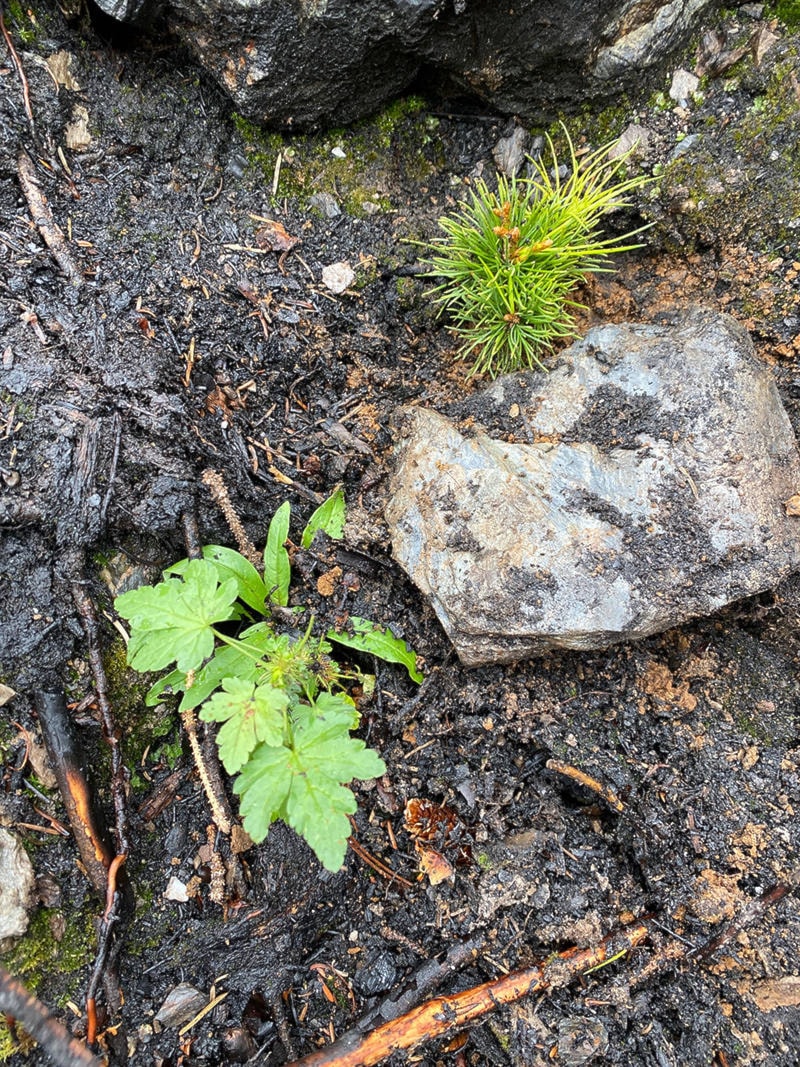Kimberley’s Randy Moody, president of the Whitebark Pine Ecosystem Foundation of Canada (WPEFC) and owner of Moody Tree, who’s spent nearly 20 years trying to preserve and promote this endangered tree species, had another big season, planting seedlings grown from seeds collected in 2018.
His group had did a massive cone collection in 2018 and it takes about two years in a nursery to get a seedling, so this year they planted around 13,000 seedlings, primarily in Kianuko Provincial park, as well as a handful of smaller study plots in areas like Hourglass Lake and Manning Park, as well as out near Lillooet.
The Whitebark Pine grows primarily in harsh subapline environments where few other plants can survive. It is a unique and important species, as it stabilizes soil in these high-elevation areas, creates habitat and provides food for grizzly bears, red squirrels and the Clark’s Nutcracker.
READ MORE: Conserving the whitebark pine tree
This bird is the only seed distributor for the Whitebark. It collects seeds to store as a winter food source, but as the bird often collects more than it needs, it forgets these seed stashes in the ground which then grow into new whitebark pines.
The tree faces a number of challenges, despite its hardy nature. These include white pine blister rust, a fungus which was introduced into the ecosystem in around 1906, mountain pine beetles, historic fire suppression and climate change.
“It’s a very interesting species and it’s great ecologically, great landscape, but it’s a challenge,” Moody said. “Not just because the disease, but because of funding and because of where it grows — it’s one of these things where there’s great opportunity and interest and excitement but the challenges are equal.”
WPEFC puts a lot of focus on the blister rust, seeking out trees that are less affected by it, collecting seeds from them and then trying to create hybrids out of the healthy trees.
“If you give this rust to every single whitebark pine, every single one will get sick. It’s just to what degree to you get sick. So there’s some that will die within a year, there’s some that’ll persist for a long time with it.”
He said that larger trees are often more resistant to rust, but not necessarily because they have a functional resistance in terms of fighting it better than others, it’s just that they’re bigger harder for the rust to kill.
“That actually presents a real challenge because big trees seem to be healthier, we don’t really know if they’re healthier.”
It’s better then to seek out 80-year-old trees who’ve grown their entire lives under the threat of rust, which has been here for around 120 years.
“Whereas these trees that are 250 years old, they might have been already big enough when rust affected them once, and it doesn’t affect them every year. Even though there’s millions of rust spores produced kind of like from a mushroom, it doesn’t mean trees are getting infected every single year, you need the right environmental conditions and there’s a lot of things at play there.”
So they collect seeds from cones out of trees in one year, then it takes two years to grow a seedling big enough to test, which is then exposed to rust. For example there are seedlings from about 30 trees growing in facility in B.C. The seedlings are all exposed to the fungus, then after even more time, they look at which ones survive the best, even though all had some infection happen.
Then, they go back to the best trees and collect more seed from them to then be bred to create, hopefully, more resistant seedlings.
They also have ways of speeding up this process. Ordinarily a seedling won’t produce cones for 40 years, but because the branches on large trees are physiologically reproductive, that branch tip can be cut off and grafted on to seedlings.
“So you’ll take these branch tips, graft them all onto seedlings and then if this is a good tree graft 50 of you, then if you’re a good tree graft 50 of you — and then they’ll do hybridization between those,” Moody explained. “So they’ll say, you were rust resistant, you were rust resistant too, let’s see when we cross you what your progeny are. And so it’s kind of a way to get the best genetics, and control pollinate the two.”
In 2018, WPEFC collected around a million seeds. Moody hoped that would last them about ten years, based on what they’d planted in years past. However, no one, other than Moody and some parks were planting them as they are not a cash crop.
Since things like the Forest Carbon Initiative, Moody said that people have begun to realize if they are cutting down whitebark pine, they should be planting it as well, even though they won’t get a crop from it. What he thought would be a ten year seed supply is likely only going to last five years, which is a good thing as it means more of these endangered trees are getting planted.
He says the increasing optics from things like the Forest Carbon Initiative, and events such as Lake Louise ski resort being fined around $2 million for the removal of whitebark pines, bodes well for the future of the species.
So what would happen if the whitebark tree were to disappear completely?
“The problem around here, you go to Bootleg mountain and it has one slope that’s just loaded with them. Where you’re going, if this all died, what would happen on this spot? And there’s other spots where it’s just a small component here and there and you’re going well if it died here, the forest is already 99 per cent subalpine fir, it wouldn’t change a heck of a lot, but there’s other sites where it would change a tonne.”
The Clark’s Nutcracker would certainly be impacted, and in some cases grizzly bears as well. Particularly so if the grizzly’s other food sources failed, such as in areas where they rely on salmon or huckleberries as they do here.
Another component to the work of WPEFC is outreach, which due to COVID was difficult this year. Moody had been working with the Kimberley Youth Action Network, where the kids would germinate seeds, a process that takes six months.
“The unfortunate thing is they were growing really well, you’ve got to look after these things and they were looking after them really well and then COVID hit and that was in March, so we kind of took all those trees and they kind of got cut off.”
Moody had devised a long-term “leapfrogging system” wherein the seedlings planted by one group in one year would be planted by another group in later years and so on. The planting should have taken place this fall, but due to issues surrounding safely planning carpooling for all the kids it just wasn’t feasible, but Moody hopes to revisit post pandemic.
Moody said he finds that it can be hard to get trees into the whitebark; if they have an interest in natural sciences, often they want to be marine biologists or work with grizzly bears, not study trees.
Moody gets it. Growing up in Lethbridge, when he moved to B.C. to do his natural resource conservation undergrad, he said he “could not care less about trees.”
However, he discovered that studying the whitebark pine also meant learning about grizzly bear interactions. As it grows high up in the mountains, he often is required to take a helicopter to work; sometimes a horse or at the very least a hike.
“So there’s the ways to get to work, it’s phenomenal, it’s endangered, there’s all these wildlife connections, that it makes it one of the more interesting plants to work with,” he explained. “So if you have a kid who’s interested in biology and they don’t want to do plants, well let’s talk about this plant and you can get the odd kid into it.”
That doesn’t mean it’s not challenging. Everything he does to preserve the species requires seeking grant funding and volunteers.
However, he said they’ve had great support this year, planting was phenomenal and there’s a lot going on for the whitebark pine from basic cone collection all the way to advanced recovery methods like grafting and producing their own seed stock.
Moody said he is grateful for the funding from organizations like the BC Parks License Plate Program, Columbia Basin Trust and the Fish and Wildlife Compensation Program.
“It takes 80 years to produce a good cone cop, 40 years to start,” he said. “And so if we’re worried about grizzly bear impact or Clark’s Nutcracker impacts, we’ve got to plan now, to make sure that in 80 years there’s trees that are producing cones.”
Next year he will have volunteer opportunities, and people can reach out to him at whitebarkrandy@gmail.com to learn more.
paul.rodgers@kimberleybulletin
Like us on Facebook and follow us on Twitter

